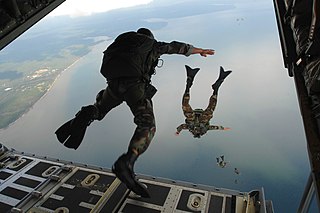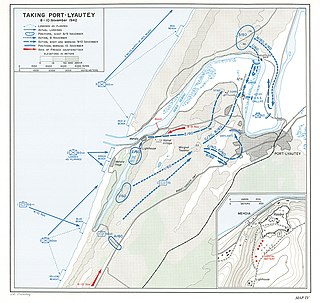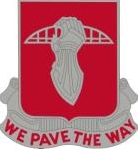
Airborne forces are ground combat units carried by aircraft and airdropped into battle zones, typically by parachute drop. Parachute-qualified infantry and support personnel serving in airborne units are also known as paratroopers.

Operation Torch was an Allied invasion of French North Africa during the Second World War. Torch was a compromise operation that met the British objective of securing victory in North Africa while allowing American armed forces the opportunity to begin their fight against Nazi Germany and Fascist Italy on a limited scale. It was the first mass involvement of US troops in the European–North African Theatre and saw the first big airborne assault carried out by the United States.

The 36th Infantry Division ("Arrowhead") also known as the "Panther Division", the "Lone Star Division", "The Texas Army", and the "T-patchers", is an infantry division of the U.S. Army and part of the Texas Army National Guard. The 36th Infantry Division was organized during World War I (1914–1918) from units of the Texas National Guard and of the Oklahoma National Guard. As an all-Texas unit, the Arrowhead Division was called to service for World War II (1937–1945) on 25 November 1940, was deployed to the European Theater of Operations in April 1943, and returned to the Texas Army National Guard in December 1945.

The 2nd Armored Division was an armored division of the United States Army. The division played important roles during World War II in the invasions of Germany, North Africa, and Sicily and in the liberation of France, Belgium, and the Netherlands. During the Cold War, the division was primarily based at Fort Hood, Texas, and had a reinforced brigade forward stationed in Garlstedt, West Germany. After participation in the Persian Gulf War, the division was inactivated in 1995.

The Battle of Kasserine Pass took place from 18-24 February 1943 at Kasserine Pass, a 2-mile-wide (3.2 km) gap in the Grand Dorsal chain of the Atlas Mountains in west central Tunisia. It was a part of the Tunisian campaign of World War II.

The Tunisian campaign was a series of battles that took place in Tunisia during the North African campaign of the Second World War, between Axis and Allied forces from 17 November 1942 to 13 May 1943. The Allies consisted of British Imperial Forces, including a Greek contingent, with American and French corps. The battle opened with initial success by the German and Italian forces but the massive supply interdiction efforts led to the decisive defeat of the Axis. Over 250,000 German and Italian troops were taken as prisoners of war, including most of the Afrika Korps.

The Amphibious Vehicle, Tracked (LVT) is an amphibious warfare vehicle and amphibious landing craft, introduced by the United States Navy and United States Marine Corps. The United States Army, Canadian Army and British Army used several LVT models during World War II, and referred to those vehicles as "Landing Vehicle, Tracked."

Operation Brushwood was a part of Operation Torch, Allied landings in Africa during World War II.

141st Signal Battalion was a United States battalion which deployed to install, operate and maintain C4I systems in support of 1st Armored Division operations, major subordinate commands and attached units as required.
Operation Reservist was an Allied military operation during the Second World War. Part of Operation Torch, it was an attempted landing of troops directly into the harbour at Oran in Algeria.
Operation Terminal was an Allied operation during World War II. Part of Operation Torch it involved a direct landing of infantry into the Vichy French port of Algiers with the intention of capturing the port facilities before they could be destroyed.

The history of the city of Casablanca in Morocco has been one of many political and cultural changes. At different times it has been governed by Berber, Roman, Arab, Portuguese, Spanish, French, British, and Moroccan regimes. It has had an important position in the region as a port city, making it valuable to a series of conquerors during its early history.

The Battle of Port Lyautey began on 8 November 1942 for the city of Port Lyautey, today known as Kenitra, in French Morocco. The battle ended with its capture and occupation by American troops, overrunning French forces after more than two days of fierce fighting.

The Run for Tunis was part of the Tunisia Campaign which took place during November and December 1942 during the Second World War. Once French opposition to the Allied Operation Torch landings had ceased in mid-November, the Allies made a rapid advance by a division-sized force east from Algeria, to capture Tunis and forestall an Axis build up in Tunisia and narrowly failed. Some Allied troops were fewer than 20 miles (32 km) short of Tunis by late November but the defenders counter-attacked and pushed them back nearly 20 miles (32 km), to positions which had stabilised by the end of the year.

The 78th Field Artillery Regiment is a field artillery regiment of the United States Army. Initially activated on 1 July 1916, the 78th Field Artillery Battalion did not see action in World War I, but would later be reactivated at the start of World War II and participate in the campaigns for Algeria-French Morocco, Sicily, Normandy, Northern France, Ardennes-Alsace, Central Europe, and the Rhineland with the 2d Armored Division. The 78th Artillery Battalion's six batteries were reorganized into separate battalions in 1957, with the 1st Battalion, 78th Field Artillery being the only remaining active unit of the 78th Field Artillery. The 1st Battalion, 78th Field Artillery is assigned to the 428th Field Artillery Brigade, supporting the Fires Center of Excellence mission through the conduct of Initial Entry Training in order to provide the Army with combat ready Field Artillery Soldiers. The 1st Battalion, 78th Field Artillery conducts Advanced Individual Training for the 13-series Military Occupational Specialties (MOS) of 13B, 13F, 13J, 13M, and 13R.
The 82nd Armored Reconnaissance Battalion was a part of the 2nd Armored Division, and was activated July 15, 1940, at Fort Benning, Georgia, for World War II. The organization was made up of trained men, from cavalry and reconnaissance units. The reconnaissance battalion was known as the "eyes and ears", of the 2nd Armored Division.

The 17th Armored Engineer Battalion was a part of the 2nd Armored Division "Hell on Wheels". During World War II, they were active in North African Campaign, and Western Europe Campaign. 17th Armored Engineer Battalion was founded on 1 October 1933 as part of the US Army. First called 17th Engineer Battalion, Motorized. It was renamed on 10 July 1940 to 17th Engineer Battalion (Armored) and assigned to the 2nd Armored Division. The unit became active and started training 15 July 1940 at Fort Benning, Georgia. Renamed again on 8 January 1942 as the 17th Armored Engineer Battalion. The Battalion is now based at Fort Cavazos, Texas. The battalion's motto was We pave the way. Tasks of the 17 included construction and demolition under combat conditions, constructing and breaching trenches, tank traps and other fortifications, bunker construction, bridge and road construction, and building destruction bridges and other physical work in the battlefield whenever needed. They also laid and cleared land mines. The 17th facilitated the movement and support of friendly forces while slowing down the enemy's forces.

During World War II, Morocco, which was then occupied by France, was controlled by Vichy France from 1940 to 1942 after the occupation of France by Nazi Germany. However, after the North African campaign, Morocco was under Allied control and thus was active in Allied operations until the end of the war.
The 6th Port of Embarkation, Headquarters Company was a combat service support unit of the United States Army serving the Transportation Corps and the Quartermaster Corps during World War II, under the command of Col. R. Hunter Clarkson, Transportation Officer of the Delta Base Section.

US Naval Bases in North Africa were sea ports and air base used in North Africa during World War II by the United States Navy. The ports and air bases supplied the troops of the Allies armies in the flight against German and Italian forces in the North African campaign and Western Desert campaign. Later the bases supported the invasion of Italy. The ports and airfields were used after their surrender in Operation Torch. Amphibious Training Bases (ATB) were built in Algeria and Tunisia to prepare for the upcoming invasions. Seabees, United States Naval Construction Battalions, did most of the repair work, new construction, and maintaining work at the bases.
















